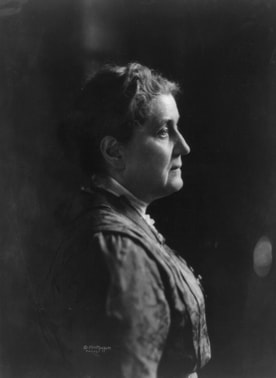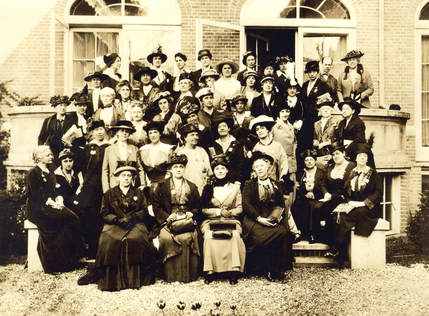 Most of us know Jane Addams as the reformer who fought poverty, crime, alcoholism, and inequality from Hull House in Chicago, founded in 1889. She was also a suffragette. She and Carrie Chapman Catt, along with three-thousand others, attended a meeting in Washington D.C. in January 1915 where the Women’s Peace Party was formed. Addams was selected to chair the new party. This led to her international leadership in attempts to end the carnage of World War I (WWI). Her history of that period was reported at the time in a social reform journal, The Survey, which is included in A. Scott Berg’s World War I and America. Some of her reports follow.  International Congress of Women in the Hague 1915 International Congress of Women in the Hague 1915 To Europe By mid-1915, women around the world were increasingly worried about a brutal war that seemed without end. European women delegates from twelve countries, both neutral and some involved in the conflict, desired a negotiated end to the war. The newly formed International Congress of Women in the Hague set a meeting for April 1915. They needed a spokesperson for their president, and Addams, being the farthest away and from a neutral country, was the best choice. She was charged with meeting with heads of states in Britain, Germany, Austria-Hungry, France, and Italy and some neutral countries—nine governments in five weeks. Those meetings and her reflections were included in a lecture at Carnegie Hall in New York when she returned in July. A Proposition The situation, she decided, is confused. She feared generalizing. But she could report that she saw “genuine emotion and patriotism in all European countries.” One problem was that leaders needed a more careful understanding that could only be obtained through first-hand impressions and experience, not from emotional “tall talk.” She heard the same causes and reasons for war. All reported that they were acting in self-defense. Any sign of willingness to negotiate had the potential of the enemy viewing them as weak. When meeting with heads of state, Addams asked directly, “If a proposition were presented to you, which seemed to you feasible…would you decline such a proposition? Would you feel justified to go on sacrificing the young men of your country…?” Not one was willing to commit. Addams also met with pacifists in her travels. They convinced her that the war was breaking down civil life that would be difficult to re-establish later, and that it was an old man’s war. Many young fighting men did not want the war, and she was told that many on both sides refused to shoot to kill. Some in England pointed to the Victorian influences of hate, intolerance, and revenge, and were saddened that the younger generation had just started to overcome this negative culture prior to the war. An International Body Why, she asked, don’t the Europeans quit the current claims and counter-claims of what has occurred before and during the war and instead “embrace the point of view of ‘what does Europe need?’” In other words, stop the “He did that to me, so I did that to him.” She suggested that, like a mother, someone should step in and say, “This can’t go on, it only leads to quarreling.” She didn’t mention ‘peace’ as she met with them, merely “can’t we see what can be done to come together and try to resolve issues in other than military ways?” Why, she wondered, are there international bodies for science and commerce, but none for international law? She denied newspaper reports that she was advising President Woodrow Wilson. But it’s possible as his later ideas regarding a league of nations reflect her comments. Epilogue The United States entered the conflict on April 6, 1917. It is ironic that President Wilson and others could not heed the advice and experience that Addams and the International Congress of Women in The Hague provided. In retrospect, maybe their work was not in vain. Perhaps they provided a model for the future. Sources: The Survey, July 17, 1915 World War I and America: Told by the Americans Who Lived It, A. Scott Berg, ed., 2017, pages 170-186 Next time: Women in WWI continues: Gertrude Bell, Nation Builder Ann Otto writes fiction based on factual as well as oral history. Her debut novel, Yours in a Hurry, about Ohioans relocating to California in the 1910’s, is available on-line at Amazon, Barnes & Noble, Kindle, and at locations listed on her website at www.ann-otto.com. Ann’s academic background is in history, English, and behavioral science, and she has published in academic and professional journals. She enjoys speaking with groups about all things history, writing, and the events, locations, and characters from Yours in a Hurry. She is currently working on her next novel about Ohio’s Appalachia in the 1920’s, and prepared for future works by blogging about a recent World War 2 European tour. She can be reached through the website, or on Facebook @Annottoauthor or www.Goodreads.com.
1 Comment
|
Archives
August 2020
Categories
All
|
 RSS Feed
RSS Feed